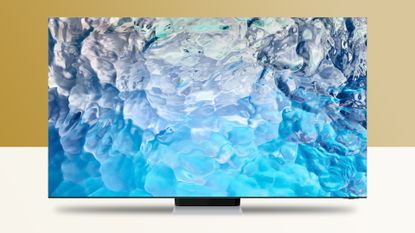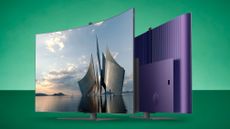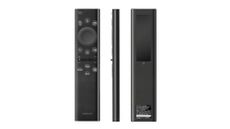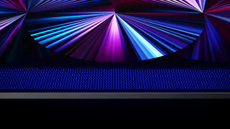The big TV news from CES 2022 is the arrival of QD-OLED – an alternative to traditional OLED TVs that mixes an OLED panel with Quantum Dot colour technology. The technology has been created by Samsung Display (though ironically Sony announced the first TV that uses it), and the company has finally given the world a first official look at screens that use it, and has explained exactly why someone would choose it over a regular OLED panel.
Sadly, T3 isn't attending CES in-person this year, but FlatpanelsHD attended a briefing with Samsung Display that gave them a real-world look at QD-OLED and gives us some real numbers for how we can expect QD-OLED to perform.
The two big advantages mentioned by Samsung Display in the briefing are in brightness and colour depth. It says that QD-OLED TVs should be able to reach 1,500 nits of peak brightness (in a window measuring 3% of the screen's total area), while still being able to dim individual pixels as dark as traditional OLED TVs can.
Over 10% of the screen (which is arguably a more useful measure), the QD-OLED panels should hit 1,000 nits of brightness. For comparison, we measured the LG G1 hitting around 750 nits of brightness in a 10% window in its Cinema viewing mode, while the triumphant Sony A90J hits around 800 nits, so we could be talking about a major upgrade here.
Both of those TVs can actually go brighter, and hit around 900 nits in a 10% window (and the Sony has been measured to hit 1,300 nits in a smaller window), but only in a special Vivid mode that is, shall we say, not really the optimal viewing experience.
So if QD-OLED can effortlessly hit 1,000 nits without any mode trickery, then it'll be a noticeable improvement over previous OLED TVs – though we'll see if these numbers hold up in the real world. Samsung Display did actually measure this brightness during the demo, according to FlatpanelsHD, but it was still a tech demonstration and not a real TV in real use, so I'm optimistic, but not putting all my chips in just yet.
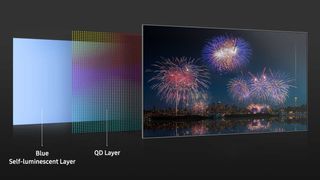
This very technical diagram explains a little bit of how QD-OLED screens work.
More colours, fewer reflections
Samsung Display also said that QD-OLED would be able to reproduce 90% of the Rec.2020 colour spectrum, which FlatpanelsHD notes is significantly better than the roughly 70% colour reproduction of current OLED panels.
This should mean a jump in realism and vibrancy compared to current OLED TVs, which are not exactly slouches in this area.
This improvement (and the brightness) are the advantages you get from adding Quantum Dot technology to OLED. Current OLED screens all require colour filters to create the images you see, but in QD-OLED those filters are replaced with Quantum Dots, which still change the colours, but do it without filtering (and so limiting) the light coming from the OLED pixels. So more light gets out (adding brightness), and it can be even more flexible for colour recreation.
And FlatpanelsHD points out that this has a bonus benefit too – fewer reflections, which actually means that the panels appear brighter in rooms with lots of ambient light (ie, most living rooms during the day).
The panels are constructed in a different way to current OLED TVs, which Samsung Display says provides wider viewing angles, though there's no problem with viewing angles on OLED TVs right now. But FlatpanelsHD spotted while looking at the actual panels that the construction also reduced reflections, which should be a relief to anyone trying to watch a moody movie on a sunny day.
It's incredibly exciting to see that all the expected improvements of QD-OLED seem like they really will come to pass – though there's a lot we don't know yet. Samsung hasn't even shown a final TV model of its own with the technology in – all we have so far is the Sony A95K. Except that a mysterious Samsung TV with 'QD-Display' has won a CES Innovation Award, and we know that this TV uses Samsung's Infinity One design (as shown at the top of this page), features four HDMI 2.1 inputs, Object Tracking Sound speakers, and a 144Hz refresh rate.
We know that the QD-OLED panels will come in 55-inch and 65-inch versions in 2022 (with other sizes to be assessed in the future based on the responses to the first models), and there will be a 34-inch size for monitors, though this won't be as bright, and won't have as wide colour reproduction.
We also don't know pricing, but we can make an educated guess based on Sony's history: the 55-inch Sony A90J, which the Sony A95K replaces, starts from $2,799/£2,699… so we could be talking some seriously premium stuff here. That's no surprise for a technology that's brand new, but it does dampen that party a little.
Update: Samsung has announced the Samsung S95B QD-OLED TV, and the price is high, but not as high as we expected.
And with classic-style OLED TVs continuing to improve (LG has announced brighter models for 2022), we'll have to see if the price of the QD-OLED is really worth the level of improvement it delivers.
